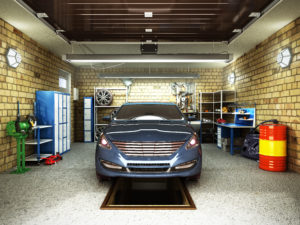Avoid Accidentally Damaging Your Car in The Garage With These Tips
June 4th, 2019 by Fix Auto USA

A garage is the best place to park your car to keep it safe, right? Well, yes and no. It makes it difficult for anyone to steal your car. But, when it comes to the chances of causing damage to your vehicle, a home garage is full of potential hazards.
As a car owner, few things are more frustrating than inflicting damage to your car in the sanctity of your own garage. Yet, it happens thousands of times a day throughout the U.S. Fortunately, the damage is usually minor. Even so, the car often needs professional repairs.
There are many things you can do to minimize or prevent the dreaded “car-damaged-in-garage” scenario. Some are common sense. Others require some work to put them in place. Here are nine tips that auto body professionals recommend.
Organization and Storage Tips
A well-organized garage is a safer garage for you and your car.
- Keep your garage neat, clean, and organized.
Whether on the road or in your garage, cars and other moving objects don’t play well together. It doesn’t take a large or hefty object to put a good-size ding in your vehicle. So, avoiding the damaged car in garage rule #1 is keep an organized garage. When you have toys, lawn equipment, bicycles, tools, and other items scattered all over the place, you’re just asking for dings and scratches (or worse) to happen. The garage is the obvious place to store these items. However, having a place for everything and everything in its place will significantly reduce the chances of one of them bumping into your vehicle.
- Keep your garage well lit.
This means day and night! Even if you have windows in the garage that let in sufficient light during the daytime, you still need good lighting at night when pulling in and out. This is especially true if parking is a tight fit for your vehicle. (Hint: use LED bulbs. They’re brighter and they save electricity.) Good lighting also helps when opening doors and unloading groceries or other items from your car to take into the house. Perhaps most important, it allows you to see objects that were left on the floor or in places where they shouldn’t be. This can help prevent you from tripping over or bumping into them and injuring yourself or your car.
- Don’t allow a child to play with cars inside the garage.
On rainy days, it can be tempting for children to want to play in the garage. On hot days a garage can be a good place to play because it offers shade and avoids sunburn. Don’t permit this kind of play without parking the car outside the garage. Otherwise, there are too many opportunities to damage your vehicle. Also, for the children’s sake, make sure any tools or potentially dangerous items are stored out of the way.
- Don’t store objects above the car.
Many people increase the storage space in their garages by hang bikes, surfboards, or other large items from the ceiling. Others will hang shelving to store equipment or boxed items. Not a bad idea – except when it’s over your car, or even to the side. Taking items down and putting them back up provides an opportunity for contact with your vehicle that can lead to unwanted damage.
- Keep the animals out.
During winter, a garage is a safe haven for rodents. The first place they will go is the warmth of your engine, where they love to gnaw wires and hoses. Placing weather-stripping at the bottom of your garage door and mothballs around windows and other entrances will help keep the pesky rodents away.
Pulling In and Out of the Garage
Not surprisingly, this is a major source of a damaged car in the garage complaints. To avoid this one:
- Install safety bumpers.
One of the most common garage accidents is pulling too far in and hitting the rear wall or whatever might be between your car and the wall (such as a washing machine or water heater). If your rear wall is clear, installing a soft bumper on it can absorb the impact, as long as you aren’t going too fast. (Hint: pulling slowly into the garage is one of those common sense things to do.) If you have a small garage with room for nothing besides your car, install the bumpers on the side walls as well. This can protect your doors when getting in and out of the car.
2. Use a tennis ball when bumpers don’t work.
If you have appliances or other items along the rear wall of your garage, installing soft bumpers isn’t an option. Instead, hang a tennis ball from the ceiling at low enough to touch your windshield. When the ball makes contact with your windshield as you pull into the garage, that’s the signal to go no further. PVC parking mats can also help prevent you from pulling too far forward. Place a mat where your front tires should rest. When you feel the bump as you roll over the first hump of the mat, that’s your stopping point. Or, simply put a block of wood on the floor at the stopping point. When you feel your front tires make contact with the block, stop going forward.
3. Go high-tech.
If you like technology, purchase a laser parking guide and mount it to the garage ceiling with the laser light shining downward at an angle. When the red laser dot reaches a certain point inside your car, you are far enough forward to park.
4. Turn your headlights on.
Technically this qualifies as a “common sense” technique, but you might be surprised how often it gets ignored. Fact is, if you can’t see where you’re going very well, you’re much more likely to bump into something, even in a garage. If it’s early morning or dusk you may not think headlights are necessary. But, if your dashboard gets significantly brighter when you turn on your headlights, it’s time to have them on. (Hint: headlights also make it safer when backing out of your garage.)
A little bit of planning and effort will go a long way to avoiding car damage in your garage. If and when it does happen, Fix Auto are the experts in fixing dings, scratches and other types of auto body damage. Come see us today at the Fix Auto location nearest you.
Welcome to
Fix Auto USA
We are the premier independent body shop network delivering world-class customer service and high-quality collision repairs across the U.S.
Learn About Us






